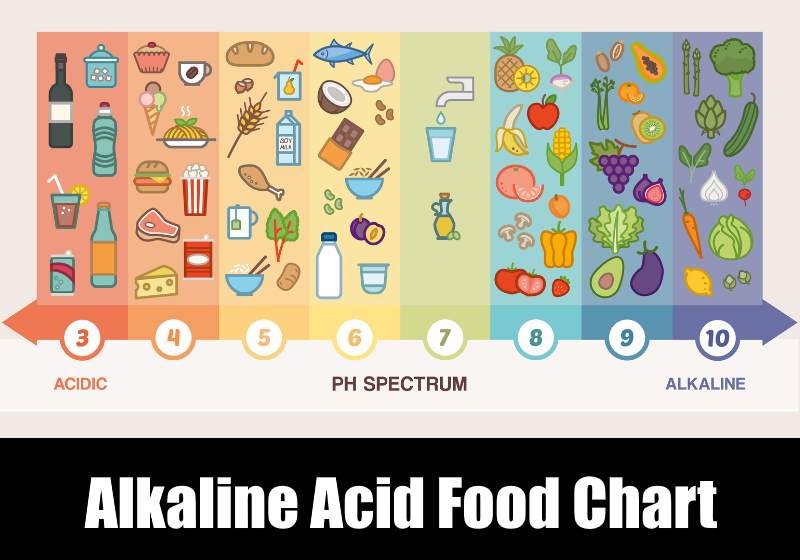There’s a great deal of information available on low pH diets. The primary claim of this diet is that most humans are too acidic and need to eat a low pH diet to bring their body back into balance with alkaline foods.
What Is pH?
Danish biochemist Soren Peter Lauritz Sorensen first described pH in 1909. The term relates to “power of hydrogen” or the ion concentration found in a water-based solution. The pH scale runs from totally acidic at 0 to totally alkaline at 14.

Important Point To Remember
When it comes to food, we need to remember that acidic foods are not necessarily acidifying to the chemistry of the body. Lemon is acidic, but lemon water is alkaline in the way it acts on the body. When studying your body’s response to food, the pH that needs monitored is post-digestion pH.
Can We Change Our pH?
Per Dr. Melinda Ratini, our blood pH is naturally between 7.35 and 7.45, or slightly acidic. To maintain this, the cleansing organs of the body such as the liver and kidneys work to shed acid content and keep blood pH constant.
While consciously changing your blood pH is not possible, an alkaline diet may be quite healthy. Alkaline diets are high in fresh fruits in vegetables, low in fat and any meat-based products. Alkaline diets also severely limit processed sugars and alcohol.
What Foods And Drinks Are Best For An Alkaline Diet?
To make sure the pH of foods you’re consuming are to the alkaline end of the scale, stick with fresh fruits and vegetables.
The best alkaline vegetables to consume are:
- cucumbers
- celery
- greens
- avocado
Health experts recommend alkaline fruits including pineapple, lemons and strawberries. Apples are also considered an alkalizing fruit.
What Are The Best Beverages For An Alkaline Diet?
Alkaline beverages include:
- coconut water
- lemon water
- almond milk.
Is milk acidic or alkaline?
The pH of milk from a cow is acidic. It’s important to note that those who need the nutrients available in animal-based milk may have better luck with goat’s milk.
The pH of soda is highly acidic. Because the pH of sugar is acid causing, any artificially sweetened beverage is not a good fit for an alkaline diet.
While fresh fruits and vegetables are generally allowed on a low alkaline diet, fruit juices tend to run acidic.
For example, the pH of orange juice is 3.35 to 4. Apple, grape and cranberry juice can also be acidic, impacting your tooth enamel as well as your overall health.
What About Caffeine?
While caffeinated coffee and black tea both contain acid and create more of it in the stomach, decaffeinated coffee contains less acid than tea.
The acid in coffee comes from the oil in the bean, and Arabica beans contain more oil than Robusta beans. Arabica beans are also thought to be more flavorful.
Decaffeinated coffee is generally made of Robusta beans.
Is decaf coffee acidic? Decaffeinated coffee has a pH of 5, which makes it slightly acidic. For anyone with a stomach condition that reacts badly to acid, decaffeinated coffee may still cause irritation.
Related | Low Acid Coffee Reviews
Is green tea acidic? Green tea contains more antioxidants than black tea, less caffeine than either black tea or regular coffee, and has a pH higher than 7. Drinking green tea is a great way to boost the alkalinity of your diet.
Does A Low pH Diet Improve Health?
One of the healthiest things about an alkaline diet is it restricts processed foods, thus lowering your intake of hidden sugars and excess sodium.
However, most alkaline diets make claims that offer anecdotal evidence but are not backed up by research.
For example, several alkaline diet programs say nothing about exercise, which is critical to weight loss and necessary for overall health.
Is It Hard To Stick To A Low pH Diet?
Staying on a low pH diet may be a difficult adjustment for some people because it involves strictly reducing the intake of meat and animal products. However, there are ways to balance out the acidity of meat by altering how you prepare it and what you combine it with.
Nearly all oils are acidifying. You can limit your exposure to oil by cooking in non-stick pans.
At Mealtime
If you do eat meat for protein, build out the rest of your meal with baked or steamed low pH vegetables such as sweet potatoes or broccoli. Put together a salad of greens, celery, tomatoes and carrots and dress it with apple cider vinegar or a dressing based on sour cream.
Nearly all grains are acidifying, so meals based on bread will need to be balanced with alkaline foods. Another option to reduce your grain exposure is to replace sandwiches with tortilla wraps (less acidic) or lettuce wraps (alkaline).
Related | Panini Press Reviews
Beverages
Sugary beverages, coffee and alcohol are highly acidifying. For cold drinks, replace soda with water and add a slice of lemon or lime. You can also make water more alkaline by amending 1 gallon of distilled water with 1/2 a teaspoon of baking soda. Shake this until the baking soda dissolves and chill.
Vegetable juices such as carrot and wheat grass are alkaline; most sweeter fruit juices such as apple and orange are acidic.
Decaffeinated coffee is less acidifying than regular coffee, and green tea is more alkaline than either.
Final Thoughts
Adding alkaline food can be gradual; an apple a day works! Cut out meat one day a week. Keep lemon water available. As your taste buds adjust, your energy may rise so you can make another adjustment on the road to wellness.











